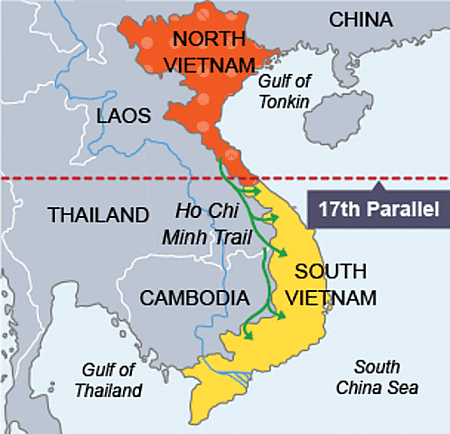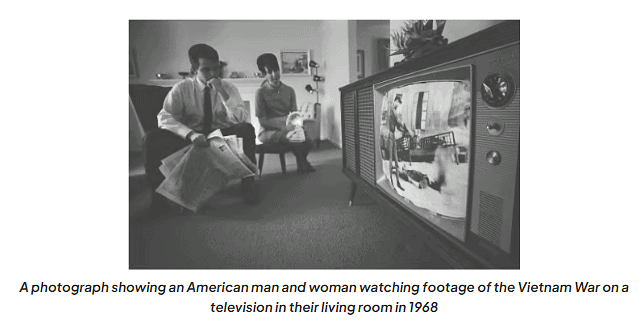Class 10 Exam > Class 10 Notes > History for GCSE/IGCSE > American Involvement in Vietnam, 1955–75
American Involvement in Vietnam, 1955–75 | History for GCSE/IGCSE - Class 10 PDF Download
Why Did the USA get Involved in Vietnam?
 A map showing how Vietnam was divided in 1954
A map showing how Vietnam was divided in 1954
- Prior to World War II, Vietnam was a French colony in Indochina.
- During World War II, Japan occupied Vietnam.
- The Viet Minh, led by Ho Chi Minh, fought against the Japanese in 1941.
- Vietnam declared independence in 1945 after World War II.
- France sought to reclaim Vietnam post-WWII, leading to conflict with the Viet Minh.
- USA financially supported France against the Viet Minh due to anti-Communist fears.
- The Viet Minh's victory over the French at Dien Bien Phu in 1954 marked a turning point.
- The Geneva Peace Accords temporarily divided Vietnam, granting the North to the Communists.
- South Vietnam established an anti-Communist regime.
- A 1956 election was planned to determine Vietnam's permanent governance.
- The Geneva Peace Accords temporarily divided Vietnam, granting the North to the Communists.


The Development of War in Vietnam
- In 1957, the Viet Minh initiated assaults on South Vietnam, marking the beginning of significant hostilities in the region.
- The Ho Chi Minh Trail was established by the Viet Minh in 1957 to facilitate the transportation of weapons to support their operations in the South.
- Ho Chi Minh escalated the conflict in 1959 by declaring a full-scale war against the Army of the Republic of Vietnam (ARVN) with the aim of toppling President Diem's government.
- A notable portion of the South Vietnamese population showed solidarity with North Vietnam's actions. In response, Ho Chi Minh founded the National Liberation Front, also known as the Vietcong, in 1960. This group comprised Communists from the North and local peasants from the South.
- President Kennedy reacted to these developments by increasing aid to bolster President Diem's administration.
- President Diem's governance faced mounting challenges as he resorted to controversial measures. In 1962, he introduced the Strategic Hamlets program, intended to create fortified villages shielded from Viet Cong influence. However, the initiative backfired, resulting in the displacement of residents and inadvertently fueling support for the Viet Cong.
- Diem's actions, such as discriminating against Buddhists, seizing land from peasants to benefit wealthy landlords, perpetuating corruption, and nepotism within his government, eroded public trust and support.
- The United States, recognizing the untenable situation, withdrew its support for Diem's regime. This culminated in a coup in November 1963, leading to the overthrow and assassination of President Diem.
Question for American Involvement in Vietnam, 1955–75Try yourself: Why did the USA financially support France against the Viet Minh?View Solution
The Events of the Vietnam War

Vietcong Tactics

 A map showing the Ho Chi Minh Trail
A map showing the Ho Chi Minh Trail
US Tactics

Question for American Involvement in Vietnam, 1955–75Try yourself: What was the purpose of the Ho Chi Minh Trail during the Vietnam War?View Solution
Why Did Public Opinion Turn Against the Vietnam War?
- Conscription became unpopular as it forced individuals into service involuntarily.
- Approximately 2.8 million US soldiers were involved in the Vietnam conflict.
- The draft disproportionately affected black Americans, causing unrest and disapproval.
- Over 9,000 young men faced legal action for evading the draft, termed as 'draft dodging'.
- The pivotal Tet Offensive of 1968 raised doubts in the media about the war's justification.
- The Vietnam War was the first war extensively covered on television, exposing the public to its harsh realities.
- Media coverage provided vivid images and reports, altering perceptions significantly.
- Incidents like the My Lai Massacre unveiled the darker side of the US Army, leading to public condemnation.
- Anti-war sentiments peaked during 1968-1970, with students emerging as a leading opposition group.
- In a notable event, around 700,000 anti-war protesters marched in Washington in November 1969.
- Tragically, in May 1970, four student demonstrators were fatally shot by the National Guard at Kent State University.
- The aftermath of the Kent State shootings triggered a nationwide student strike involving 2 million students from 400 educational institutions.


The Consequences of the End of the Vietnam War
- President Nixon's electoral victory in 1968 was fueled by his commitment to conclude the Vietnam War. Alongside his close advisor, Henry Kissinger, Nixon aimed to extricate the U.S. from the conflict with grace.
- Following the ineffective bombing campaigns in Laos and Cambodia, Nixon initiated the phased withdrawal of American troops. This gradual exit strategy commenced in January 1973.
- The Paris Peace Accords, signed in January 1973 between the U.S. and North Vietnam, marked the formal conclusion of American military involvement in Vietnam. Nixon hailed this as a 'peace with honor'.
- By 1973, only a modest contingent of 30,000 U.S. troops remained stationed in Vietnam, while the internal strife between North and South Vietnam persisted.
- The definitive moment arrived on April 30, 1975, when Saigon, the capital of South Vietnam, succumbed to the advancing North Vietnamese military forces.

- After a period of containment, the US government altered its strategy.
- Nixon initiated détente with both the USSR and China.
The document American Involvement in Vietnam, 1955–75 | History for GCSE/IGCSE - Class 10 is a part of the Class 10 Course History for GCSE/IGCSE.
All you need of Class 10 at this link: Class 10
|
81 videos|87 docs|18 tests
|
FAQs on American Involvement in Vietnam, 1955–75 - History for GCSE/IGCSE - Class 10
| 1. Why did the USA get involved in Vietnam? |  |
Ans. The USA got involved in Vietnam to prevent the spread of communism in Southeast Asia and to support the government of South Vietnam in its fight against the communist forces of North Vietnam.
| 2. What were the Vietcong tactics during the Vietnam War? |  |
Ans. The Vietcong employed guerrilla warfare tactics, such as ambushes, booby traps, and hit-and-run attacks, to combat the larger and more technologically advanced American forces.
| 3. How did US tactics differ from Vietcong tactics during the Vietnam War? |  |
Ans. US tactics in Vietnam focused on conventional warfare strategies, such as search and destroy missions, air strikes, and the use of superior firepower, while the Vietcong relied on guerrilla tactics to wear down the enemy.
| 4. Why did public opinion turn against the Vietnam War? |  |
Ans. Public opinion turned against the Vietnam War due to mounting casualties, the lack of a clear objective, growing opposition to the draft, and the perception that the war was unwinnable and morally wrong.
| 5. What were the consequences of the end of the Vietnam War? |  |
Ans. The end of the Vietnam War led to the unification of North and South Vietnam under communist rule, the displacement of millions of refugees, the reintegration of veterans into society, and a period of healing and reflection for the United States.
Related Searches















